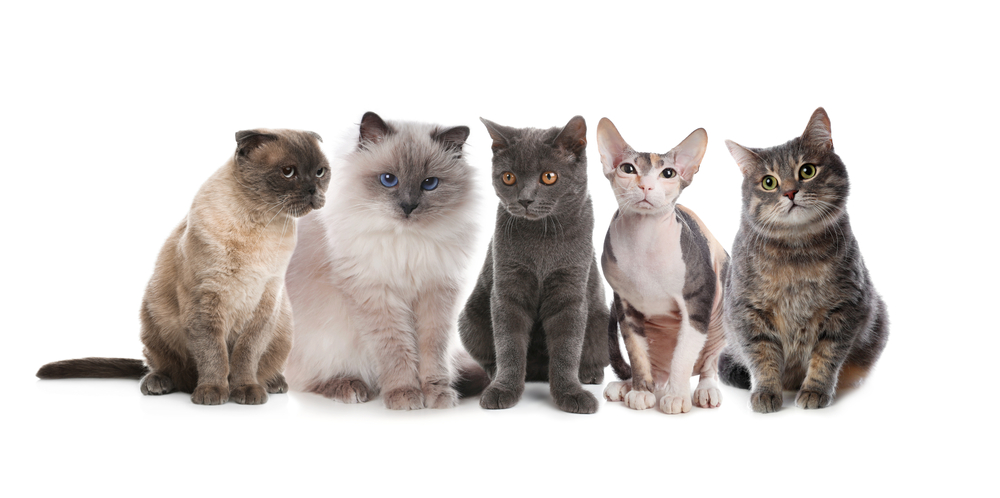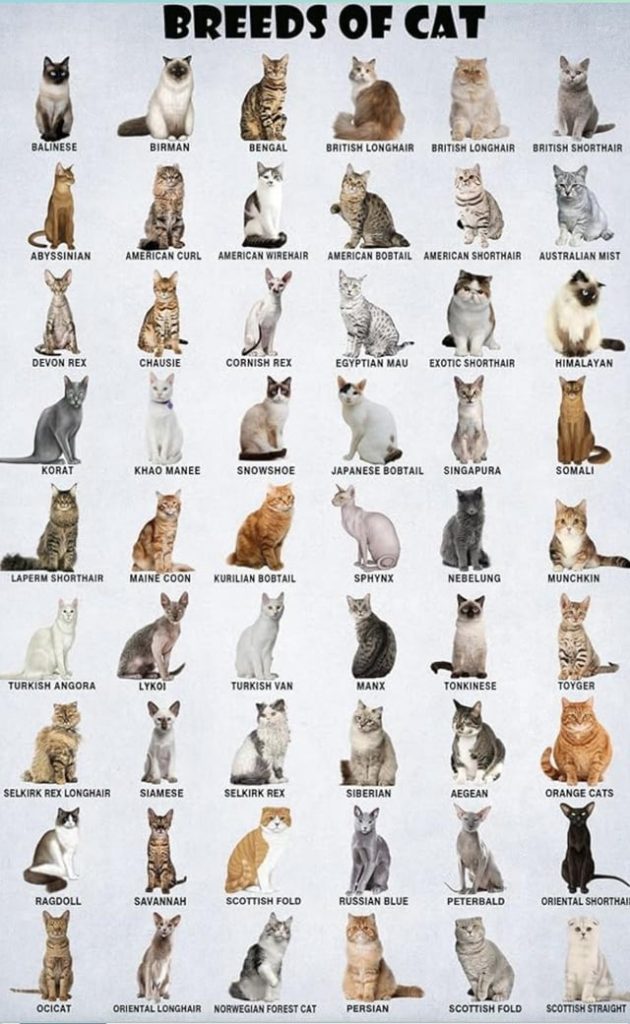Have you ever wondered about the breed of your mysterious feline friend? Maybe your cat has an unusual coat pattern, or perhaps there’s something unique about its behavior that has piqued your curiosity.
Identifying the breed of your cat can be both fascinating and rewarding. It not only helps you understand your pet better but also allows you to cater to its specific needs more effectively. Knowing the breed can provide insights into health predispositions, temperament, and even preferred activities.
In this guide, we’ll reveal simple methods you can use to determine your cat’s breed without needing a degree in veterinary science. Prepare to uncover the secrets of your furry companion and deepen your bond through understanding.
Physical Characteristics
Understanding a cat’s physical traits can help identify its breed. These traits range from coat length to eye color. Observing these features is key. Each characteristic provides clues about a cat’s ancestry. Let’s explore these in detail.
Coat Length And Texture
Coats can be short, medium, or long. Short-haired cats have sleek coats. Long-haired breeds, like Persians, have flowing fur. Texture varies too. Some cats have soft, silky fur. Others might have coarse or curly coats. The texture often hints at specific breeds.
Color Patterns And Markings
Color patterns are diverse in cats. Tabbies have striped or spotted coats. Calicos display three distinct colors. Siamese cats are known for their point coloration. Solid-colored cats exist too. Patterns and markings can reveal breed lineage.
Body Size And Shape
Cats come in various sizes and shapes. Maine Coons are large and muscular. Singapuras are small and delicate. Body shape can suggest breed origins. Some cats have slender frames. Others are stocky and robust.
Eye Color And Shape
Eye color varies widely among breeds. Siamese cats have striking blue eyes. Green eyes are common in Russian Blues. Eye shape also differs. Some cats have round eyes. Others have almond-shaped eyes. These features add to a cat’s uniqueness.

Credit: www.ovrs.com
Behavioral Traits
Cats display unique behavioral traits that can help determine their breed. Observe their playfulness, social interactions, and vocal habits. These traits often reveal distinct breed characteristics, aiding in identification.
Understanding your cat’s behavioral traits can help identify its breed. Each breed has unique characteristics. Observing these can provide valuable insights. Below are some key behavioral traits to consider.Activity Level
Some cat breeds are very active. They love to play and explore. Breeds like the Abyssinian often have high energy levels. They enjoy climbing and need plenty of stimulation. On the other hand, Persian cats are more laid-back. They prefer lounging and require less exercise. Observe how your cat spends its day. This can be a clue to its breed.Vocalization Patterns
Cats communicate through vocalization. Some breeds are very talkative. Siamese cats are known for their loud meows. They often “talk” to their owners. In contrast, the Russian Blue is quieter. They meow less and are more reserved. Notice your cat’s vocal habits. It can hint at its breed type.Social Interaction
Different breeds have different social behaviors. Ragdolls are very affectionate. They enjoy human company and often follow their owners. In contrast, the British Shorthair is more independent. They enjoy their space but still show affection. Understanding your cat’s social traits is key. It helps in identifying its breed. Observe your cat closely. You may discover new insights about its breed.Genetic Testing
Discovering your cat’s breed can be exciting. Genetic testing offers a scientific approach to identify breed characteristics. This test analyzes your cat’s DNA, revealing unique traits and lineage.
Determining your cat’s breed can feel like solving a mystery. But genetic testing offers a reliable way to uncover the secrets of your feline friend’s lineage. It’s like having a DNA detective in your pocket, ready to reveal the rich tapestry of your cat’s ancestry. By understanding your cat’s genetic makeup, you can not only satisfy your curiosity but also gain insights into their health and behavior.Understanding Dna Kits
DNA kits for cats have become increasingly popular. They usually include a simple cheek swab that you use to collect your cat’s DNA. After sending the sample to a lab, you’ll receive a detailed report in a few weeks. These kits are designed to be user-friendly. You don’t need to be a scientist to use them. Just follow the instructions, and soon you’ll have a better understanding of your cat’s breed background. Have you ever wondered why your cat has such unique markings or a distinct personality? A DNA kit can help solve that puzzle. By identifying specific breeds in your cat’s genetic history, you can learn more about their traits and tendencies.Interpreting Test Results
Once you receive the results, you might feel overwhelmed by the data. But the reports are usually broken down into easy-to-understand sections. They’ll show you a percentage breakdown of your cat’s breed composition. You might discover that your seemingly ordinary tabby has a dash of Siamese or a hint of Maine Coon. These insights can help you understand their quirks and preferences. Consider this: knowing your cat’s breed can also guide you in providing better care. Certain breeds are prone to specific health issues or have unique dietary needs. With this information, you can tailor your approach to keep your feline friend happy and healthy. Have you ever used a DNA kit for your cat? How did it change your understanding of your pet? Share your experiences in the comments below! Your insights could help other cat owners on their journey to discover their pet’s true breed identity.
Credit: es.pinterest.com
Common Cat Breeds
Determining your cat’s breed can be quite fascinating. Common cat breeds each have unique characteristics that set them apart. Whether it’s the fluff of a Persian or the sleek elegance of a Siamese, knowing the breed can help you understand your cat’s behaviors and needs. Let’s dive into some popular breeds you might encounter.
Persian
Persians are known for their long, luxurious coats and sweet demeanor. They often have large, expressive eyes that can melt your heart. Their grooming needs are high due to their dense fur. Does your cat love lounging and staying close to you? If yes, you might have a Persian on your hands.
Maine Coon
Maine Coons are one of the largest domestic cat breeds. They have tufted ears and a bushy tail, making them look majestic. They are friendly and often act like dogs, following you around the house. Have you noticed your cat’s dog-like behavior and impressive size? It could be a Maine Coon.
Siamese
Siamese cats are recognized for their striking blue eyes and pointed color pattern. They are vocal and love to communicate with their owners. Their sleek, short coat requires minimal grooming. If your cat likes to engage in conversations and has a distinctive color pattern, it might be a Siamese.
British Shorthair
British Shorthairs are known for their round faces and dense, plush coat. They are often calm and easygoing, making them great companions. Their broad, muscular bodies give them a sturdy appearance. Does your cat have a plush coat and a laid-back attitude? You might have a British Shorthair.
Understanding your cat’s breed can enhance your bond and tailor care to their unique needs. Have you identified your cat’s breed yet? If not, take a closer look at these characteristics. Your feline friend might be more special than you think.
Mixed Breeds
Mixed breed cats are common and diverse. They don’t fit into a single breed category. These cats have traits from multiple breeds. Understanding their traits can be challenging. But it is fascinating. Mixed breeds offer unique personalities and appearances. They are beloved by cat enthusiasts worldwide.
Identifying Traits
Identifying traits in mixed breed cats requires observation. Look for fur patterns and colors. Notice eye shapes and sizes. Pay attention to body structure and size. Mixed breeds may have unique ear shapes. Tail length and fur texture are also important. Each trait can hint at ancestral breeds. Compare these traits with known breeds. This can provide clues about their origins.
Common Mixed Breeds
Some mixed breeds are more recognizable. The Domestic Shorthair is widespread. It features a variety of colors and patterns. The Domestic Longhair has lush fur and diverse appearances. Tuxedo cats are known for their distinct black and white coats. Tabby cats have striped or spotted patterns. Calico cats are known for their vibrant fur colors. Each mixed breed has unique characteristics. These make them special and adored.

Credit: www.reddit.com
Using Online Resources
Determining your cat’s breed can be an exciting journey, especially when you utilize the vast amount of online resources available. While traditional methods like consulting a vet are valuable, the internet provides a wealth of information at your fingertips. From specialized tools to engaging with online communities, the digital world offers numerous ways to identify your feline friend’s breed.
Breed Identification Tools
Several websites and apps are specifically designed to help you identify your cat’s breed. These tools often require you to upload a photo of your cat and answer a few questions about their physical features and behavior.
- Cat Scanner App:This app uses AI technology to analyze images of your cat and suggest possible breeds. It’s user-friendly and offers quick results.
- Cat Fanciers’ Association:Their website provides a comprehensive list of cat breeds with detailed descriptions, helping you match your cat’s characteristics.
These tools are not just for fun. They can provide insights into your cat’s behavior and health needs. Have you ever wondered why your cat loves water or has a unique coat pattern? The answer might lie in their breed.
Online Communities And Forums
Sometimes, the best insights come from fellow cat lovers. Online communities and forums are bustling with people eager to share their knowledge and experiences.
Joining platforms like Reddit or specialized cat forums can connect you with experienced cat owners. They can offer advice based on personal experiences, which can be incredibly valuable.
These communities are also great for sharing photos and getting direct feedback. You might post a picture of your cat, and within minutes, receive multiple suggestions about its breed. Do you have a unique-looking cat that leaves everyone guessing? An online community might just have the answer you’re looking for.
Engaging with others can also lead to learning about various breeds’ quirks and traits. Have you ever joined an online forum and discovered something surprising about your cat’s possible heritage? It’s these unexpected insights that make the journey of breed identification truly rewarding.
Consulting A Veterinarian
Consulting a veterinarian helps identify your cat’s breed with accuracy. They assess physical traits and behavioral patterns to provide insights. This understanding can guide you in offering the best care for your feline friend.
Determining your cat’s breed can be an exciting journey, filled with curiosity and discovery. But what happens when you hit a roadblock with online resources and breed charts? This is where consulting a veterinarian comes in. A vet can provide insights that go beyond the obvious, offering professional assessments and health considerations that you might not have thought about.Professional Assessment
Veterinarians are trained to recognize the subtle differences between cat breeds. They can help identify specific traits like coat texture, ear shape, and tail length. These characteristics are often key indicators of a breed’s identity. When I got my cat, Max, I was sure he was a Maine Coon because of his fluffy tail. My vet, however, pointed out that his ears weren’t tufted, a common Maine Coon trait. This professional input saved me from misidentifying him. Have you observed any unique features in your cat that might indicate a specific breed? Vets can also use genetic testing to confirm a breed, providing a more precise identification.Health Considerations
Each cat breed comes with its own set of health profiles. Understanding these can help you take better care of your furry friend. Vets can highlight any breed-specific health risks that you should be aware of. For example, Persian cats are prone to respiratory issues due to their flat faces. Knowing this, you can take preventive measures to ensure their wellbeing. Consulting a vet can also provide insights into nutritional needs. Different breeds may require different dietary considerations. This could mean altering your cat’s diet to better suit its breed-specific needs. Do you know if your cat’s breed has any specific health requirements? Your vet can guide you through the necessary precautions. This way, you can ensure your pet leads a healthy and happy life. Engaging with a veterinarian not only helps in identifying your cat’s breed but also equips you with the knowledge to cater to its unique needs. So, the next time you’re at the vet, why not ask them about your cat’s breed traits and health considerations?Frequently Asked Questions
How Can I Tell What Breed My Cat Is?
Identify your cat’s breed by observing physical traits like fur, size, and color. Consult a vet or use DNA kits for accurate results. Research online breed databases for additional information.
Can Google Lens Identify Cat Breeds?
Yes, Google Lens can identify cat breeds. It uses image recognition technology to analyze photos of cats. This app helps users learn about different breeds and provides relevant information. Simply take a picture, and Google Lens will do the rest.
It’s a handy tool for cat enthusiasts.
How Can I Identify A Cat?
Identify a cat by its retractable claws, whiskers, and pointed ears. Look for a flexible body, sharp eyes, and a distinctive meow. Cats have a variety of coat colors and patterns. Check for a long tail and a habit of purring when content.
How To Identify A Domestic Shorthair Cat?
Identify a domestic shorthair cat by its short, sleek coat and diverse colors or patterns. They have a muscular build and round face. Their eyes and ear shapes vary, making them adaptable and healthy. They are known for their friendly, playful nature and are popular in households.
Conclusion
Determining your cat’s breed can be both fun and educational. Start by observing physical traits. Notice fur length, color, and patterns. Check the size and shape of the ears and tail. Behavior also gives clues. Is your cat playful or calm?
Research different breeds online. Compare your findings. DNA tests offer precise results. Consult a vet for expert advice. Understanding your cat’s breed enhances care and bonding. You’ll connect better with your furry friend. Enjoy the journey of discovery. Happy exploring!
